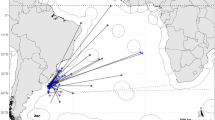Summary
The biotic and abiotic electric phenomena in the habitat of the electrosensitive catfish,Ictalurus nebulosus LeS were investigated. Fish, insect larvae, tadpoles and snails proved to possess electric fields that can be described as stationary fields of the dipole type, upon which fluctuations, due to respiration or other movements, are superimposed. The frequency components of these fields fall within the DC to 10 Hz range, whereas the potential gradients are in the order of magnitude of 10 mV/m. The maximal potential differences found were several millivolts. These measurements were carried out in tap water with a specific resistance ρ = 20 Ω · m. Further, hydroelectric fields were measured in some find-localities ofIctalurus. Potential gradients up to 15 mV/m have been recorded in water with a specific resistance ρ = 110 Ω · m. These fields proved to be stationary, fairly constant in direction and strength, and strongly dependent on the structure of the bottom of the pool and the depth of the water. The possible significance of these biotic and abiotic fields toIctalurus is discussed.
Similar content being viewed by others
Literature
Arx, K. von: An introduction to physical oceanography. Reading, London: Addison-Wesley 1962.
Barham, E. G., Huckabay, W. B., Gowdy, R., Burns, B.: Microvolt electric signals from fishes and the environment. Science164 (3882), 965–968 (1969).
Bennett, M. L. V.: Electric organs. Ann. Rev. Physiol.32, 471–529 (1970).
Bogorov, V. G., Demenitskaya, R. M., Gogodnitskiy, A. M., Kazanskiy, M. M., Kontorovich, V. M., Litvinov, E. M., Trubiatchinskiy, N. N., Fedorov, V. D.: Character and causes of the vertical variation of the natural electric field in the ocean. Oceanology9, 622–626 (1969).
Bureš, J., Petran, M., Zachar, J.: Electrophysiological methods in biological research. London: Academic Press 1960.
Cagniard, L.: Electricité tellurique. In: Handbuch der Physik, Bd. XLVII (S. Flügge, ed.), S. 407–469. Berlin-Göttingen-Heidelberg: Springer 1956.
Cox, C. S., Filloux, J. H., Larsen, L. C.: Electromagnetic studies of ocean currents and electrical conductivity below the ocean-floor. In: The sea, vol. IV, part I (Maxwell, ed.), p. 637–693. London: Wiley 1971.
Dijkgraaf, S.: Electroreception in the catfish,Amiurus nebulosus. Experentia (Basel)24, 187–188 (1968).
Dijkgraaf, S., Kalmijn, A. J.: Versuche zur biologischen Bedeutung der Lorenzinischen Ampullen bei den Elasmobranchiern. Z. vergl. Physiol.53, 187–194 (1966).
Harder, W.: Nachweis aktiver (elektrischer) Ortung bei Mormyridae (Teleostei, Pisces). Z. Tierpsychol.30, 94–102 (1972).
Kalmijn, A. J.: The electric sense of sharks and rays. J. exp. Biol.55, 371–383 (1971).
Kleerekoper, H., Sibakin, K.: An investigation of the electrical “spike”-potentials produced by the sea lamprey (Petromyzon marimus) in the water surrounding the head region. II. J. Fish. Res. Bd. Canada14 (2), 145–151 (1957).
Krajew, A. P.: Grundlagen der Geoelektrik. Berlin: V.E.B. Verlag 1957.
Machin, K. E.: Electric receptors. In: Biological receptor mechanisms. Symp. Soc. exp. Biol.16, 227–245 (1962).
Park, P. K., Bradshaw, A. L., Menzel, D. W., Schleicher, K. E., Curl, H. C., Jr.: Changes in the electrolytic conductance of seawater during photosynthesis and respiration. J. Oceanogr. Soc. Japan25 (3), 119–121 (1969).
Parker, G. H., Heusen, A. P. van: The response of the catfish,Amiurus nebulosus, to metallic and non-metallic rods. Amer. J. Physiol.44, 405–420 (1917).
Peters, R. C., Buwalda, R. J. A.: Frequency response of the electroreceptors (“small pit organs”) of the catfish,Ictalurus nebulosus LeS. J. comp. Physiol.79, 29–38 (1972).
Roth, A.: Electroreception in the catfish,Amiurus nebulosus. Z. vergl. Physiol.61, 196–202 (1968).
Roth, A.: Elektrische Sinnesorgane beim ZwergwelsIctalurus nebulosus (Amiurus nebulosus). Z. vergl. Physiol.65, 368–388 (1969).
Roth, A.: Zur Funktionsweise der Elektrorezeptoren in der Haut von Welsen (Ictalurus): Der Einfluß der Ionen im Süßwasser. Z. vergl. Physiol.75, 303–322 (1971).
Sabben, D. van: Personal communication (Koninklijk Nederlands Meteorologisch Instituut, de Bilt).
Spoor, W. A., Neiheisel, T. W., Drummond, R. A.: An electrode chamber for recording respiratory and other movement of free swimming animals. Trans. Amer. Fish. Soc.100, 22–28 (1971).
Author information
Authors and Affiliations
Rights and permissions
About this article
Cite this article
Peters, R.C., Bretschneider, F. Electric phenomena in the habitat of the catfishIctalurus nebulosus LeS. J. Comp. Physiol. 81, 345–362 (1972). https://doi.org/10.1007/BF00697755
Received:
Issue Date:
DOI: https://doi.org/10.1007/BF00697755




